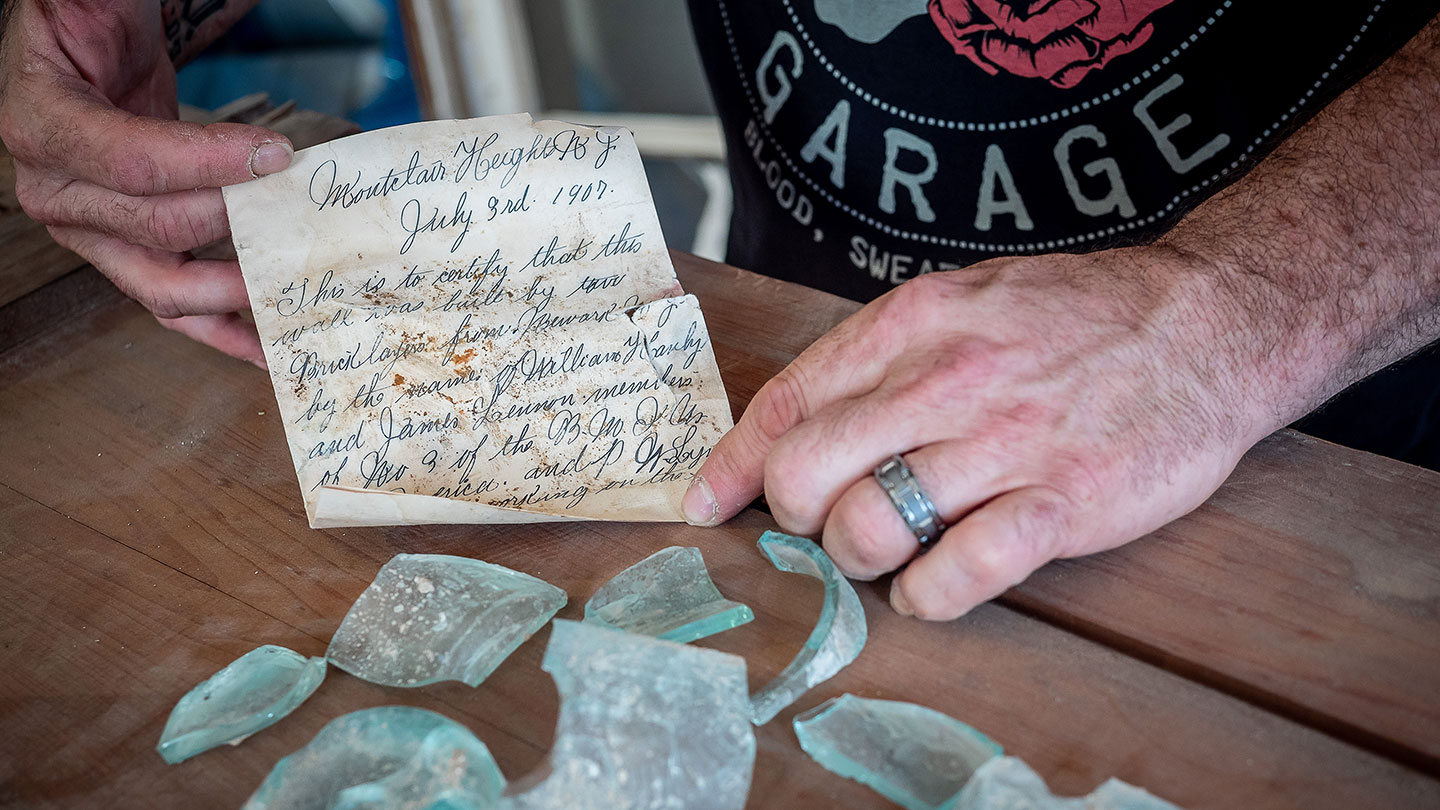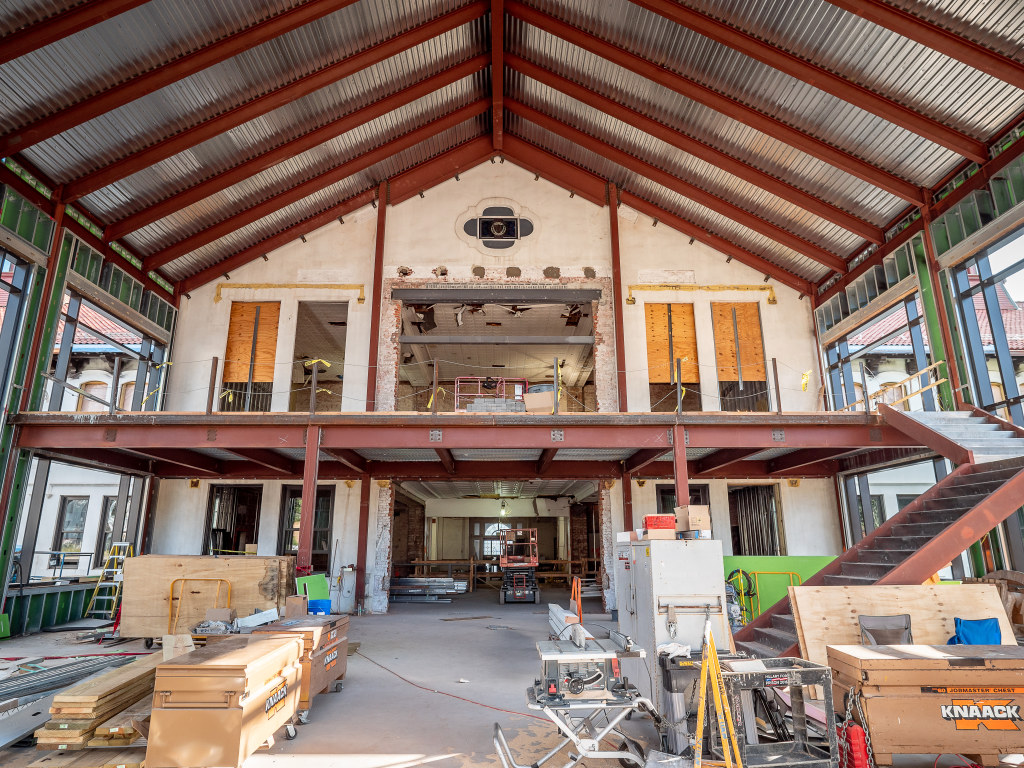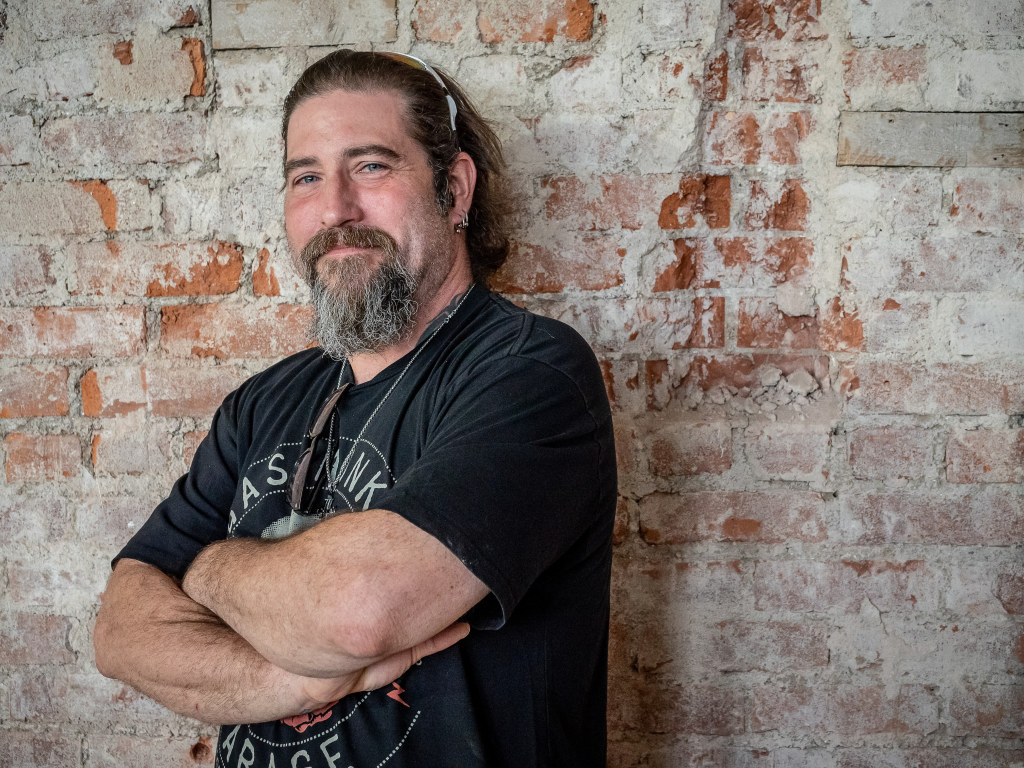
Message
In A Bottle
A hidden history in College Hall reveals the muscle and sweat that brought public education to life
The message and broken bottle were discovered during the renovation of College Hall.
On July 3, 1907, craftsmen slathering mortar for a massive supporting wall for the origins of Montclair State University, laid down their trowels and slipped a message into a bottle.
“This is to certify that this wall was built by two bricklayers from Newark, N.J., by the names of William Hanly and James Lennon, members of No. 3 of the B.M.I.U. of America.”
Their wall was the building block, effectively, for a new school training teachers of students from all social classes and genders, their children and their children’s children.
Buried deep within College Hall, the message would take 112 years to be discovered.
“It’s wild to think of that,” says Sharon Mahoney, the University’s director of construction management. “The message has been sitting there dormant for 100 years just waiting for us to find it.”
The Discovery
Fast forward to the renovation of College Hall, the centerpiece of campus. Standing in the spot where the wall once stood, Robert Kanaby, a demolition laborer, recreates the discovery.
Using a chipping hammer to break bricks six feet high and three layers thick, “I hit a void and I heard glass break,” he recalls. “And I’m like, ‘Something’s not right.’ So, we took away the debris and I found the glass and then I found the note.”
Dated July 3, 1907, the note ensured the bricklayers who laid the foundation for higher education in Montclair would be written into its history. “It gave me chills to realize what I had come across,” Kanaby says.
Intrigue Builds
There’s long been a fascination with the recovery of messages. “These little bottled notes are powerful – every bit as intoxicating as the spirits they held before they became time capsules,” says Clint Buffington.
Buffington is a collector of messages and is featured in a new documentary film, The Tides That Bind, which looks at the history of bottles cast out to sea and the authors who sent them. When told about the discovery at Montclair State, Buffington says the story “ignites something in the romantic heart.
“You knock down a wall and a bottle falls out and a note falls out of a bottle? I dream about that kind of stuff.”

The message was placed inside a beer bottle, the pieces of the mystery coming together from clues in the broken glass and research from the Montclair Historical Center. The bottle was manufactured by the Consolidated Bottling Co. and was made for pale ale or porter.
You can imagine then a hot summer’s day more than a century ago, with flags flying in town in anticipation of the Independence Day fireworks, the bricklayers in Montclair Heights taking their lunch from a tin pail, perhaps bread with meat or cheese, and savoring a pale ale. Writing in blue pen in a cursive script, they composed the note on parchment, rolling it to fit into the now-emptied glass bottle.
They created a secret compartment between the first and third layers of brick. “They took the time and love to put this wall together,” to take ownership of a job done well by writing their names, what they did and where they were from, Kanaby says. “And we took it down. That was an experience for me.”
Census records could point to their identities. Most likely, Hanly and Lennon were first-generation Irish laborers. Was William Hanly the writer of the note? The penmanship is the fanciful script learned in school and the 1920 Census notes that a William J. Hanly, age 33, living on Central Avenue, Newark, was able to write. A bricklayer born around 1875 named James Lennon is listed in the 1930 Census. He rented a Newark home on Summit Street with his wife, Tillie, and daughter Eileen, then age 16.
A Campus Transformation
The family trees remain elusive. But we do know that countless hours of hard physical work by immigrants and laborers like Hanly and Lennon went into the construction of the original mission-styled building completed seven months ahead of schedule.
Over the decades, generations of students, many the first in their families to achieve a higher education, have passed through its doors, their strength and persistence mirroring the muscle and grit of the turn-of-the-century laborers.
“We have built this University with sweat equity, amazing ourselves and others with what we have been able to accomplish,” said President Susan A. Cole in her spring address to the University community. “Our students are also building their futures with sweat equity, quite literally, and they are amazing themselves and others with what they can accomplish.”
It’s the kind of work, she says, that is never finished.
This summer, the modernization of College Hall will bring together all student services. While maintaining the original look, including orange tiles and decorative tin ceilings, it’s been redesigned with a dynamic atrium and café.
With plans calling for an open floor plan, crews took on the monumental task of tearing down some of the original structural walls. It was during the final phase of demolition, on the first floor near Kasser Theater to make room for the restaurant, that Kanaby heard the sound of breaking glass.

“He brought the note to me,” Mahoney recalls, “in a paper sack and says, ‘I’m sorry I broke the bottle.’ We could have renovated that building and never touched the wall. It’s pretty amazing.”
Act of Faith
Montclair State is hoping to connect the long-ago writers with their descendants if discovered. There are plans to exhibit the message, bottle and other artifacts found at the construction site, says Mike Zanko, the University’s associate vice president for Capital Planning and Project Management.
Vintage glass bottles were found discarded when digging an underground vault for information technology. Stone masons found a 1940s’ business card belonging to C.H. Little, a business representative for the craftworkers labor union, BMIU of Montclair, No. 11, with “offices at 617 ½ Bloomfield Ave., Montclair, NJ.” The message in the bottle notes that P. W. Lynch “was also working on the job.”
“Someone always wants to leave some kind of message, even if it is just initials, or a small artifact hidden in the work,” says Montclair historian Mike Farrelly. “They want it to be hidden so the owners or bosses don’t get angry, but there is always a glimmer of hope that someone will find it one day.”
Buffington says it was an “act of faith” that the note left by the bricklayers in 1907 would ever be recovered.
The wall was huge, at least 18 inches thick and meant to be there for a very long time. Hanly and Lennon had to know their note could only – and then only possibly – be found if and when the wall was torn down.
“If you found one message on campus, there could be others,” Buffington says. “Who knows what words are yet to be discovered.”